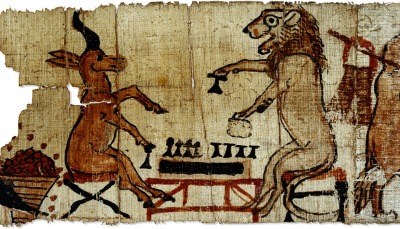Egyptian erotic papyrus
The Turin Erotic Papyrus is a famous (or rather, infamous) 12th/11th century BC Egyptian papyrus, divided into two parts, giving a unique insight into attitudes toward comedy and sex in ancient Egypt. It was discovered in Deir El-Medina in the early 19th century, and has been described as the "world's first men's mag."
The first section is satirical - it humorously shows humanized animals performing tasks such as playing musical instruments, climbing trees to pick fruit, quarreling and driving chariots. The second section is erotic - it explicitly shows a bearded man engaging in various different acrobatic sex acts with a female courtesan.
The papyrus is said to represent attitudes towards sex in Egypt that were very relaxed and erotic, yet also discreet and kept behind closed doors. The papyrus was "completed" (since fragments are missing) digitally by Wild Dream Films in 2009, as part of a documentary for the History Channel titled Sex In The Ancient World - Egyptian Erotica. It is on display today in the Museo Egizio in Turin.
External links
http://heritage-key.com/egypt/turin-erotic-papyrus
Chat rooms • What links here • Copyright info • Contact information • Category:Root

